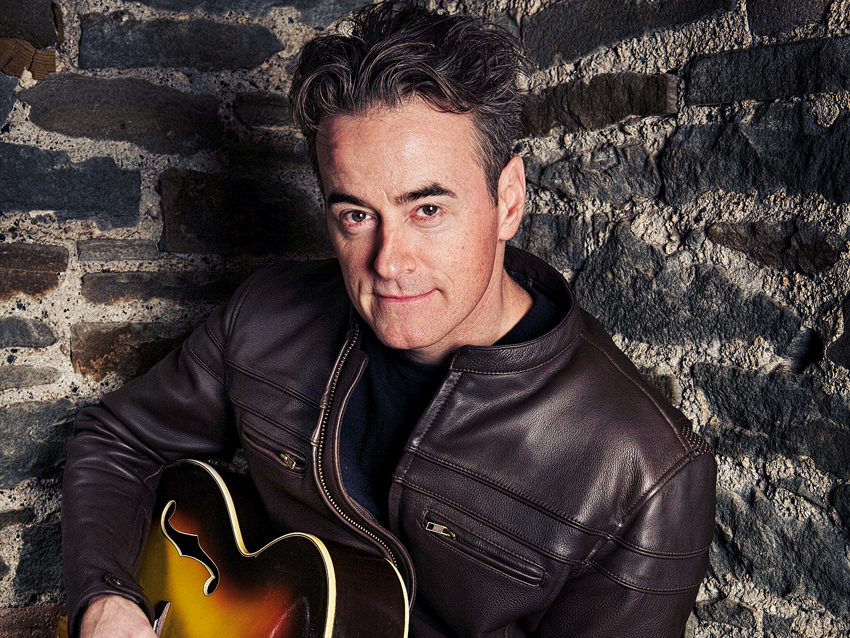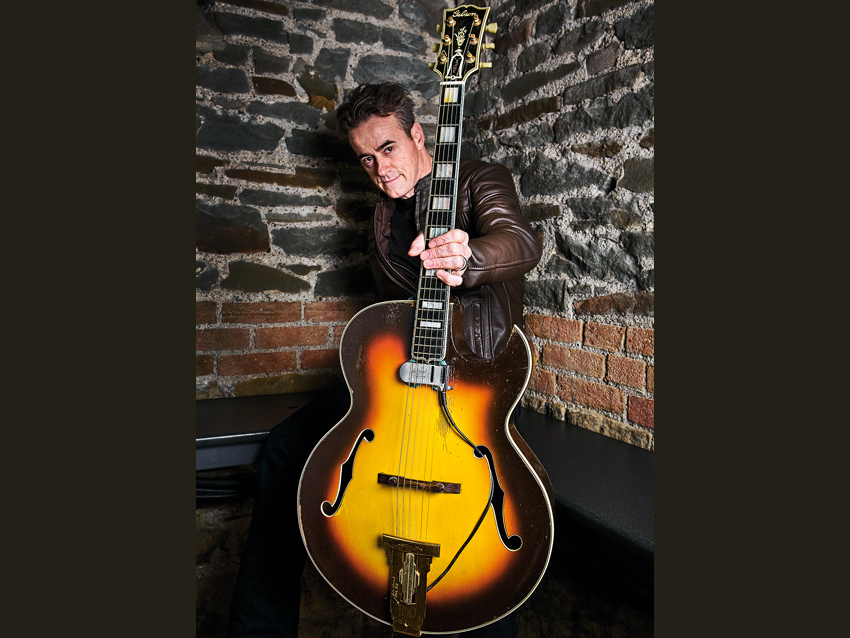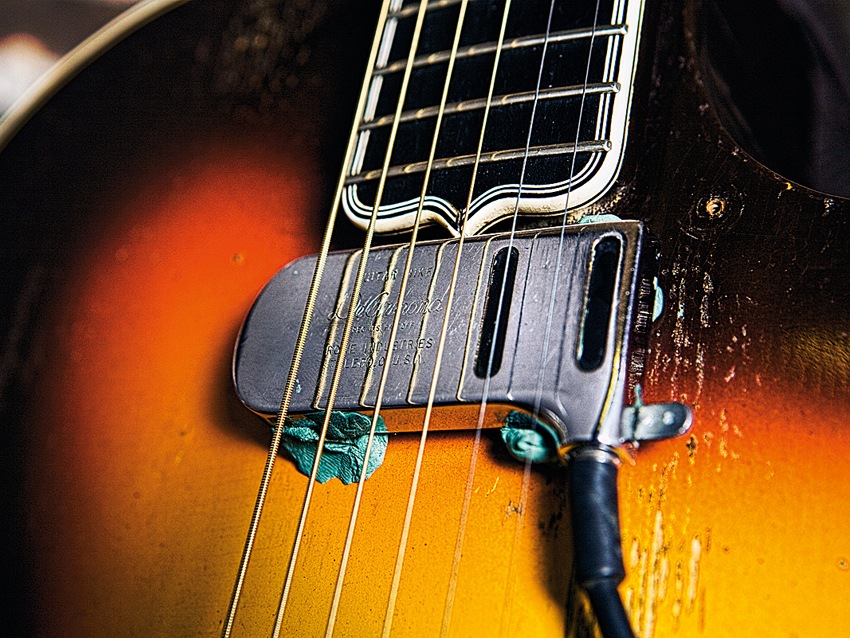Interview: Hot Club of Cowtown's Whit Smith

Interview: Hot Club of Cowtown's Whit Smith

Interview: Hot Club of Cowtown's Whit Smith

Interview: Hot Club of Cowtown's Whit Smith
You won't believe Whit Smith's guitar playing until you witness it in person. A pre-1950s-inspired mix of Western swing, jazz and Hot Club styles, there's never an inversion too far, a pattern too tricky nor a harmony unexplored as he takes your every expectation and surpasses it.
Alongside Elana James and Jake Erwin, the noise they make in Hot Club Of Cowtown is as seemingly incongruous in 2011 as it is engaging. "It's all live y'know, no overdubs," replies the genial guitarist as we ask about the band's latest release, What Makes Bob Holler, a tribute to Western swing's celebrated pioneer.
"They're all Bob Wills songs on the new record," confirms Whit, "and because it's all been done live and it's just the three of us in a room with minimum separation, we're all playing more or less at full tilt. We're throwing in everything that we've got. It's raw, we use all of our chops - we're playing Western swing!"
The trio format - particularly with no drummer - must leave you a lot of space as a guitarist, so what approaches do you use?
"Well Eldon Shamblin, the guitar player in Bob Wills' band, is famous for moving the chords around. A lot of swing guitar players in the '20s and '30s would be up and down the neck; it was a two-chord song, but they're playing dozens of chords, so that's prevalent.
"When I'm playing rhythm, say you have a G with the third in the bass, then I got a D7 with the seventh in the bass, then a diminished... a G with a fifth in the bass for example. You can hear that there and that's a Western swing characteristic.
"But I'm pretty traditional. It's a little bold to say I'm trying to be a contemporary of my influences, but what I'm saying is that I never add an obvious rock or folk thing. It's a pre-'50s idea - there's only a hundred billion ideas that came before that time anyway [laughs], so there's plenty to do!"
Get the MusicRadar Newsletter
Want all the hottest music and gear news, reviews, deals, features and more, direct to your inbox? Sign up here.
You comp rhythm one second, play melodies the next, and then play solos. How do you deal with that without a channel switch or pedal to vary volume?
"If you work at it, it starts to come together. Like drummers who sing - it's one of those things that comes when you work at it!
"Over the last year I've been stepping on a pedal for solos when I play live, but for the first 10 years I didn't. I was trying so hard to overcome what most people figure out pretty quickly - use a pedal! I'd like to stop using it, but it'd mean my amp being a little louder.
"As it is, the amp is wide open, so I strum lightly when I play chords and hit harder when I play solos. Also I use bronze strings, which don't have the same signal as nickel.
"I think it helps because when you're strumming bronze strings it's not as loud as nickel or flatwounds. But then you switch to the unwound strings and punch 'em hard. And I use 0.012s or 0.013s, remember.
"It's hard for me to step on a pedal though. Even my wife teases me - she used to like how I'd walk up to the mic stand without stepping on something. I'm trying to be slick now and just sneak it in."
So what pedal do you use?
"It's the Møller by T-Rex. The idea was just to get a clean boost. I tried about a dozen of 'em and the Gibson amp just couldn't handle them.
"The Møller was the thickest, darkest sound - it distorts a little too much for my taste, but the audience seems to respond to that. Wow - they finally know I'm taking a solo! But on the record though, it's just the amp - no pedals!"
Bronze strings: don't they sound too bright for you?
"Well, I definitely don't use phosphor bronze - they are too bright. I use the 80/20 Bronze, and I'm judging them through the DeArmond pickup.
"I used to use 0.013s, but I found that with the amp I could get away with 0.012s, which is nice because when you travel all day and get out and play the guitar, 0.013s can be kinda rough!
"But I still put a 0.013 and 0.017 on the top, and of course I don't bend anywhere near as much as a blues or rock player."
And the guitar is happy with that?
"Oh it's made to hold much heavier than that. At home, I'll put a 0.015 and an 0.018 on it. I have a routine every morning - I get up, warm up, practise and just play acoustic.
"I wish that was the way I could always do it because the tone is just beautiful. You lose a lot when you thin the strings down, but it's okay, it's a trade off."
Many musicians would find the idea of recording a trio 100 per cent live somewhat intimidating… maybe even impossible?
"Everything's live - you just sit in the chair and play. Well I say 'sit'. The first day I sat, then the second day I stood, and I kinda wish I'd stood the whole time.
"You gotta' remember to stay loose, but there's an energy in standing - it's unmistakable. I heard Eddie Van Halen used to like to stand when he recorded."
The feel is better stood up, but accuracy is better sitting down?
"I feel that I play better when I sit down, especially for the right-hand technique and the right-hand tone, the way you have the complete advantage over the strings when you're sitting down with your whole arm ploughing through the strings.
"But what you lose in that technique when you stand, you get back in a certain kind of energy. That's more so live, but whatever, I felt that I sang and played with a little more juice when I stood in the studio too!"
On A Maiden's Prayer, we could almost swear we can hear a couple of overdubs…
"Nope, no overdubs: nothing! I can kinda guess at what you might have heard. I use a lot of sixes - sixth intervals - on adjacent strings and you're covering a lot of the chord and a lot of the scale tones, then the fingers that are not being used, you can hit notes in between. It can get very thick and busy."
It's almost as if you're ghosting, like a drummer might do on a snare…
"Right. You might hit two notes in the initial attack, but if the riff has three or four notes, you might only just be catching it, or it might be ringing over it…
"And when you play lines on adjacent strings, you get a natural, physical tension. You can play the same two notes and skip a string - a difficult way of playing a sixth on a guitar. If you do that on adjacent strings, it's all kinda thick and it sort of makes the speaker want to leap out of the amp.
"I base that on Thumbs Carllile, the guitar player who tuned in E flat major and played [across his lap] with all his fingers on the fingerboard. He had a lot of closed voicings; he played fiddle tunes and much of the stuff he was using sounded like it had actual violin influence.
"Of course I work with the violin a lot and obviously they are tuned in fifths. They just bar their finger, add another finger and they've got a six or a seven chord real quick - it's very dramatic sounding, really quickly. So I thought, I gotta' get some of that into my guitar playing."
The last time we spoke with you, you were about to start using a new amp…
"The Lazy J - yeah, I did a whole tour with it, and there are clips on YouTube of me using it. I used it at the Cambridge Folk Festival too. We've since moved it into a head and cabinet design - I wanted that because I travel a lot and if I take it on an airplane, I want to bring the electronics with me. It now has a 15-inch Tayden speaker and they sound fantastic.
"The whole focus was to take the original Lazy J and start to blend it with what happens with my Gibson amp - that pre-WWII sound. Amps had very little bass and very little high-end back in those days - it was very mid-range centric.
"We sat there for hours and played - for every three or four hours you have one eureka moment."
Any amp revelations during that process?
"I've been trying to think of a way to explain this and why it works… So originally I had too much top end for what I was looking for. Then when you back off on the tone knob, it kinda sounds like you're putting a blanket over the amp, almost as if everything has to suffer to compensate the high end. And here we're just talking about maybe the high E string sounding a little tinny to me.
"So one of the major challenges that Jesse [Hoff, Lazy J amps] definitely has a handle on is that. I remember working on the amp just before a show. I'd play the high E string, third fret - a G note - and I'd say to Jesse, I want this G to sound like this G, which was the G string at the 12th fret.
"It's the exact same note, right? But it may as well be the difference between a saxophone and a trumpet! Why do they sound so different? It's almost like you have to notch frequencies - take things out so that everything that's on can be fully bright, like when you have your guitar volume up it really sounds responsive and it feels great. Then you start backing off and it dies down.
"Well I want those mids to have a lot of clarity and definition, but without the tinny top string. We're 90 per cent there."
So the amp situation is well in hand - what about guitars. Do you carry a spare?
"Nope. Although recently I just got a [Gibson] Super 300, 1948, and it's the guitar that I'm holding in the album pics. It's a really cool guitar. It has a monster 18-inch maple body - it's a good cowboy guitar.
"It's great but I think I'll always be an L-5 guy - I'm a one-guitar guy!"











